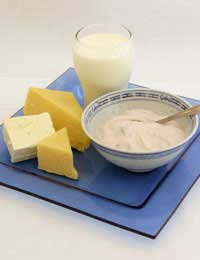
Dairy products, including milk and cheese, can be successfully frozen to prolong their storage life. If you’re saving money or you have a big family, it’s very useful to understand what you can and can’t freeze. Here’s our guide.
Safe Freezing Tips
- Cool hot foods thoroughly before freezing.
- Use clean or preferably new freezing containers or bags with airtight seals.
- To save space, buy a vacu-seal kit – available for less than £30.
- Freeze products on the date of purchase or preparation, following packaging guidelines.
Freezing Yoghurts
If you wish to freeze yoghurt, use a pot that has not been half-eaten, and freeze it as soon after buying as possible. Food Standards suggests opening a snack-sized pot of yoghurt, putting in a clean (preferably new, not washed) lollipop stick and putting the pot into the freezer. But you can freeze plain yoghurt too – thaw thoroughly in the fridge and whisk before using in your recipe. Try our Easy Strawberry Yoghurt recipe, below:
You need:
- 200g fresh strawberries, washed and hulled
- Seeds from 1 vanilla pod
- 1-2tbsp caster sugar
- 2tbsp lemon juice
- 350ml plain yoghurt
To make:
- Put the first four ingredients into a blender and whiz until smooth.
- Taste to see if it needs any more sugar or lemon juice it should be fairly sweet at this stage.
- Tip the plain yoghurt into a freezer-proof container, and stir in the strawberry puree.
- Put into the freezer.
- After two hours, remove from the freezer and beat hard with a wooden spoon to break up any ice crystals.
- Repeat twice more at two-hour intervals.
- Remove from the freezer 20 minutes before serving to soften.
Freezing Cheese
The British Cheese Board advises,
“Most cheeses do not freeze well although Stilton will keep in a freezer for up to three months wrapped in foil or cling film. …Other cheeses can be frozen but on defrosting they may become rather crumbly. However, although the texture will be altered, they should still taste good.”
A certain well-known British cook – with a recent book on shortcut cookery – makes no secret of her reliance on frozen cheddar. Grate it directly into a freezer bag, vacuum-pack if possible, seal, label, and freeze. It can be sprinkled (frozen) straight onto pizzas or gratins, as it will defrost and melt in the oven.
Freezing Milk
It’s absolutely OK to freeze milk, which is handy to know if you don’t have a corner shop for emergency supplies. Make sure you freeze it promptly – don’t wait until the ‘best before’ date. Pour a little bit out and then put the container (not glass) into the fridge. To use, defrost overnight (it could take longer), shake well, and use as normal.
No-Churn Ice-Cream!
Of course, we couldn’t discuss frozen dairy products without a quick mention of one of our favourites – ice-cream! Making no-churn ice-cream is easier than you’d think, all you need to do is follow two basic principles. First, add a splash of spirit, which prevents the cream from freezing into rock-solid crystals. Second, use 1 part sugar to 2 parts double cream + fruit (or nuts or chocolate) mix. To illustrate – try folding pureed white peach into whipped double cream, and adding half its weight in sugar, finish with 2tbsp peach schnapps, and freeze. Or experiment with your own ideas – the sky’s the limit!
